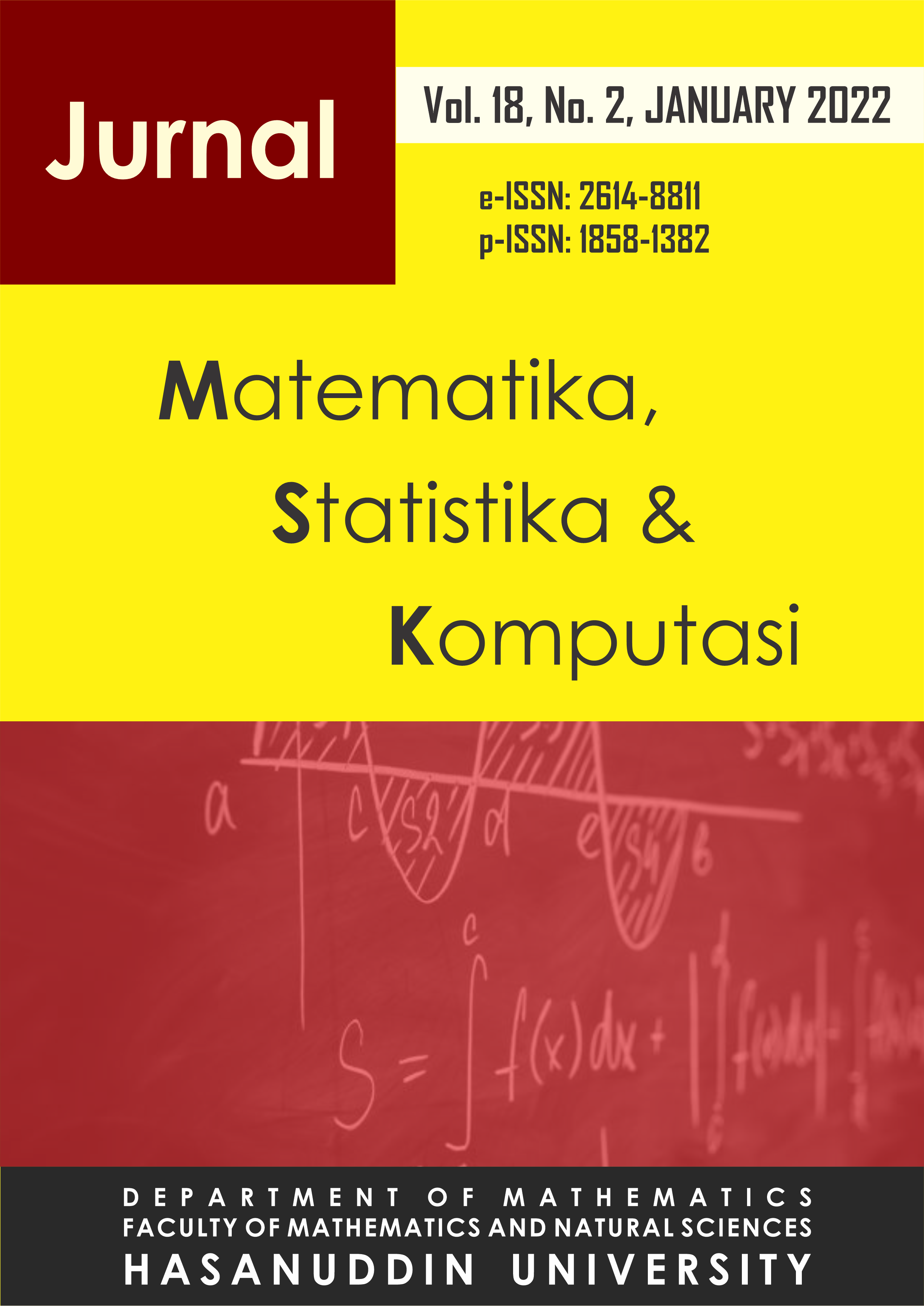Forecasting Stock Price PT. Telkom Using Hybrid Time Series Regression Linear– Autoregressive Integrated Moving Average Model
DOI:
https://doi.org/10.20956/j.v18i2.18837Keywords:
Harga saham, hybrid TSR linier-ARIMA, peramalan, trendAbstract
The hybrid method is a method of combining two forecasting models. Hybrid method is used to improve forecasting accuracy. In this study, the Time Series Regression (TSR) linear model will be combined with the Autoregressive Integrated Moving Average (ARIMA) model. The TSR linear model is used to obtain the model and residual value, then the residual value of the TSR linear model will be modeled by the ARIMA model. This combination method will produce a hybrid TSR linear-ARIMA model. The case study in this research is stock closing price (daily) of PT. Telkom Indonesia Tbk. The stock closing price (daily) of PT. Telkom Indonesia Tbk in 2020 showed an decreasing and increasing trend pattern. The results of this study obtained the best model of hybrid TSR linear-ARIMA (2,1,1) with the proportion of data training and testing is 70:30. In the best model, the MAD value is 56.595, the MAPE value is 1.880%, and the RMSE value is 78.663. It is also found that the hybrid TSR linear-ARIMA model has a smaller error value than the TSR linear model. The results of forecasting the stock price of PT. Telkom Indonesia Tbk for the period 02 January 2021 to 29 January 2021 formed a decreasing trend pattern.
References
Aswi & Sukarna, 2006. Analisis Deret Waktu: Teori dan Aplikasi. Makassar: Andira Publisher.
Bowerman, B.L. & O’Connell R.T., 1987. Time Series Forecasting: Unified Concepts And Computer Implementation: Second Edition. United States of America: PWS Publishers.
Box, G.E.P. & Cox, D.R., 1964. An Analysis of Transformations. Journal of the Royal Statistical Society. Series B (Methodological), Vol. 26, No. 2, 211-252.
Daniel, W.W., 2000. Applied Nonparametric Statistics (2nd Ed.). Boston: Duxbury Press.
Hajirahimi, Z. & Mehdi K., 2019. Hybrid structures in time series modeling and forecasting: A review. Engineering Applications of Artificial Intelligence, Vol. 89, 83-85.
Hejase, H.A.N. & Ali H.A., 2012. Time Series Regression Model For Prediction Of Mean Daily Global Solar Radiation In Al-Ain UEA. International Scholarly Research Network (ISRN) Renewable Energy. Vol. 2012, 1-9.
Hyndman, R.J. & Athanasopoulos, G., 2018. Forecasting: Principles and Practice: Second Edition. Monash University, Australia. https://otexts.com/fpp2/. [10 November 2021].
Jannah, M. & Indah N.F.H., 2019. Penaksiran Parameter Model Autoregressive Orde (1) Dengan Menggunakan Metode Likelihood Maksimum. Mathematics & Applications Journal, Vol. 1, No. 2, 43-44
Makridakis, S., Wheelwright S. C., & McGee V. E., 1999. Metode dan Aplikasi Peramalan, Jilid 1. Jakarta: Erlangga.
Montgomery, D.C. & Johnson L.A., 1998. Forecasting and time series analysis. United States of America: McGraw-Hill Inc.
Oberstone, J., 1990. Management Science: Concepts, Insights, and Applications. New York: West Publisher Co.
PT. Telkom Indonesia, 2020. Tentang Telkomgroup. https://www.telkom.co.id/sites/about-telkom/id_ID/page/profil-dan-riwayat-singkat-22. [10 November 2021]
Rencher, A. C. & Schaalje G. B., 2008. Linier Models in Statistic Second Edition. New Jersey: Wiley and Sons
Subagyo, P., 1986. Forecasting Konsep dan Aplikasi. Yogyakarta: BPFE Yogyakarta.
Wei, W.W.S., 2006. Time Series Analysis Unvariate and Multivariate Methods: Second Edition. New York: Pearson Education Inc.
Zhang, G.P., 2003. Time series forecasting using a hybrid ARIMA and neural network model. Neurocomputing, Vol. 50, 159-173.
Downloads
Published
How to Cite
Issue
Section
License
Copyright (c) 2021 Author and publisher

This work is licensed under a Creative Commons Attribution 4.0 International License.

This work is licensed under a Creative Commons Attribution 4.0 International License.
Jurnal Matematika, Statistika dan Komputasi is an Open Access journal, all articles are distributed under the terms of the Creative Commons Attribution License, allowing third parties to copy and redistribute the material in any medium or format, transform, and build upon the material, provided the original work is properly cited and states its license. This license allows authors and readers to use all articles, data sets, graphics and appendices in data mining applications, search engines, web sites, blogs and other platforms by providing appropriate reference.







